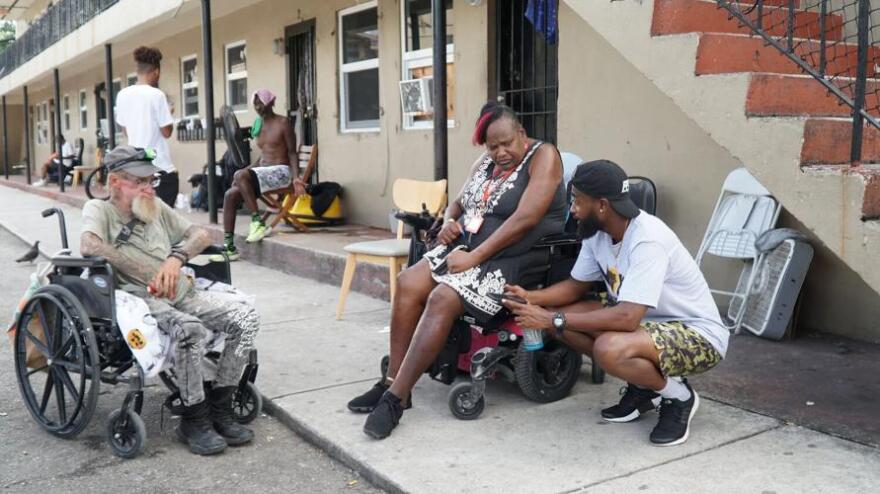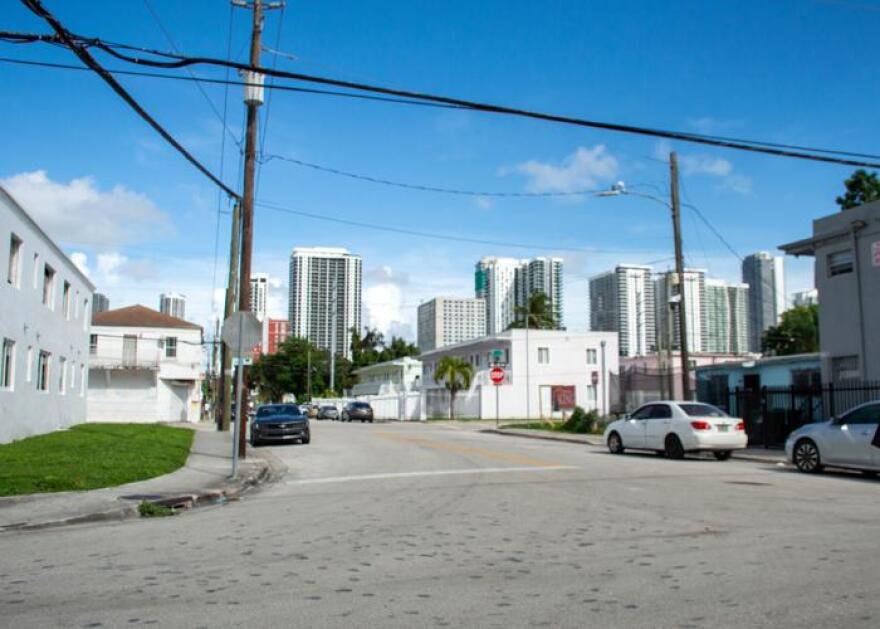On a warm Saturday afternoon, a group of residents, activists and community leaders gathered at Gibson Park in Overtown not just to stroll through its streets, but to reclaim them as their own. The walking tour, coined “This Is Our City,” became the first in a series organized by The Black Collective, a grassroots group devoted to building Black political, economic and social power in Miami-Dade County.
For more than two hours, participants walked through historic sites and listened to stories of resilience, displacement and survival, reflecting on what the neighborhood once was — and what it’s still fighting to become.
“This is about preserving the culture of Black Miami,” said Moise “Moe” Simbert, organizing director for The Black Collective. “We want to make sure that people who come to Black Miami experience that culture — whether they’re in Overtown, Little Haiti or Liberty City. And for the people that are within Miami, we want to make sure they’re not being displaced, not being pushed out.”
The Black agenda
The walking tour is one of several initiatives emerging from The Noir Project, a campaign that began in 2022. Over nine months between 2023 and 2024, The Black Collective canvassed more than 10,000 Black and Afro-Latino residents across 27 ZIP codes to learn about their priorities in four areas: safety, health, democracy and vision.
“Whether it was sheltered, unsheltered, documented or undocumented, we wanted to get a true appearance for people of the community,” said Simbert. “People were telling us that nobody really came into the community … We took the Noir Project as the initiative to get the real facts to start making real changes.”
The findings, compiled into a 30-page report, became the foundation for The Black Agenda, a platform outlining policy demands based on what Black Miamians said they needed.
Top concerns included secure jobs, affordable housing, fewer guns, access to mental health services and free clinics, and a stronger voice in local decision-making. Sixty percent of respondents said they felt their voices didn’t affect policymaking.
“Housing is not a luxury; it is a right,” the Black Agenda reads. “We built this city — yet we are pushed out, priced out, left out. We demand free, accessible housing for all.”

Walking through history
The Overtown tour, led by lifelong resident and volunteer guide Jacqueline Conney, brought that history into focus. As she led residents and group members along Northwest Third Avenue, Conney described how once-affordable apartment complexes in front of Gibson Park have been replaced by developments out of reach for longtime residents.
“Those used to be apartment complexes that ranged from $400 for a one-bedroom, $650 for a two-bedroom,” said Conney, signaling a building now called Island Living Apartments. “People could afford to live there. Then they made programs to help with Lotus House and Section 8. But all the elders that were there — where did they go?”
Today, Island Living’s one-bedroom units range from $685 to $1,313, while its two-bedroom units range from $819 to $1,812.
The tour passed landmarks like St. John Institutional Missionary Baptist Church, founded in 1906, and Lil Greenhouse Grill, one of the first new Black-owned businesses to open in Overtown before the redevelopment boom. Conney shared how small acts of care, like the restaurant’s weekly free meals, keep the spirit of Overtown alive even as gentrification reshapes its streets.
But change is visible everywhere. Conney recalled how lots once selling for $10,000 skyrocketed to $90,000 in a few years, displacing many residents.
“Under this overpass,” she said, signaling toward I-395, “used to be at least 20 to 70 houses. They stayed there because you had shelter from the rain, shelter from the sun. But they tore it all down.”
After the tour, The Black Collective members surveyed additional residents to continue their efforts in housing advocacy. For Simbert, the tour was more than a history lesson; it was a chance to witness displacement in real time.
“While we walk by the side of the highway, next to Camillus House, next to where people are sleeping on the ground, but we have a whole bunch of empty buildings where we need to be asking our government officials to hold them accountable and asking them, why is this not housing?

Voices from the ground
Sunya McKenney, a longtime resident of Carol City, spoke of skyrocketing rents and the disappearance of low-income housing.
“They took the low-income places. They knocked them down, not just in Miami, but Miami Gardens and other parts of Dade County, and they’re making it unaffordable,” she said. “I’ve come close to eviction so many times because my rent is unaffordable. I’m on a fixed income. My rent is $2,100. No central air, I had to buy my own window units. The landlord refused to.”
David Peery, a former attorney turned housing advocate, shared how a traumatic eviction changed his life.
“I was a victim of a false arrest and a self-help eviction by two off-duty police officers working for my landlord,” he said. “I became homeless, lost all my possessions. That really changed the whole trajectory of my life.”
Peery, who once lived in Overtown, said that walking through the neighborhood again showed him how much has changed.
“Over the past 10 years, Overtown has just changed dramatically,” he said. “All of the integrated neighborhood-type housing, all the longtime families, almost every single one of them are gone.”
Peery believes history is repeating itself, as rising rents and new construction reflect the turmoil caused by I-95 and I-395 decades ago.
“The past — it’s just happened all over again, and the improvements they’ve been making to the highway destroyed the last meaningful shreds of the neighborhood.”
Still, Peery sees glimmers of hope.
“There’s still some life and vibrancy here,” he said. “Some people still retain the old character of the neighborhood. We need protections — eviction prevention, protections for seniors, for people who’ve been here for years. Because when you destroy that community, you destroy the whole character of our city.”
What’s next
The Overtown walking tour was just the beginning. The Black Collective is planning more tours, with the next one scheduled for Little Haiti on Saturday, Oct. 18, 2025, to continue documenting, preserving and organizing around Miami’s Black cultural heritage.
Simbert said the tours also serve as a “time capsule” for future generations.
“I feel like our mission as a Black Collective is to be that time capsule — to say, ‘In 2025, around housing, what was Black Miami doing? How did Black Miami feel? What changes and impacts were we making?’”
Next, the group plans to partner with other organizations on housing.
“We’re hoping to compile this information, keep it current and raw, and use it to set a broader table to have more impactful conversations on how we can make some real impactful solutions in Miami,” Simbert said.
This story was produced by The Miami Times, one of the oldest Black-owned newspapers in the country, as part of a content sharing partnership with the WLRN newsroom. Read more at miamitimesonline.com.





